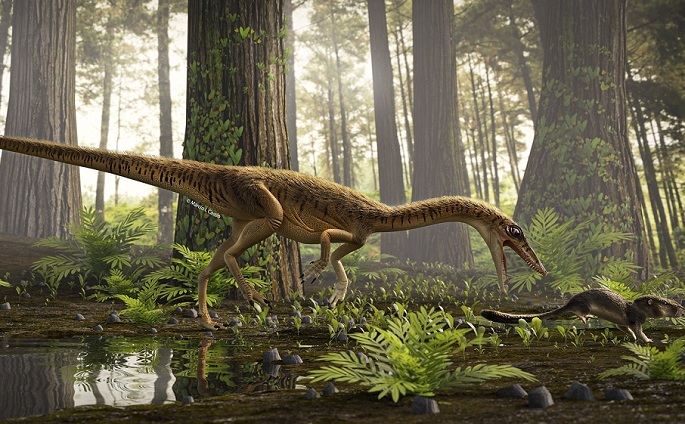Ancient T. Rex ancestor discovered in Brazil
Published : 03 Dec 2020, 21:58
An ancient ancestor of Tyrannosaurus Rex that lived at the dawning of the dinosaur era - roughly 230 million years ago - has been discovered by researchers in southern Brazil.
"Erythrovenator jacuiensis," which also was a predator, though smaller in size, is regarded as one of the earliest theropods, a dinosaur clade that includes T. Rex and the different velociraptor species and was characterized by hollow bones and three-toed limbs.
The discovery was made by Brazilian paleontologist Rodrigo Temp Muller of the Federal University of Santa Maria and was described in an article recently published in the Journal of South American Earth Sciences.
Muller identified the new theropod taxon based on a specimen that comprises a proximal portion of a left femur and was discovered in 2017 at a rural property in Agudo, a municipality in Brazil's southernmost state of Rio Grande do Sul.
"We had few fossils of these types of dinosaurs, most of them quite fragmented. This one I discovered is just one bone that's quite worn, but it has characteristics that are only seen in the theropod clade," Muller said in statements to Efe.
"And within that clade, it belongs to an animal we weren't aware of until now. Even though it's just a bone, features are visible that we hadn't seen in other dinosaurs," he added.
"Erythrovenator jacuiensis" means "red hunter of the Jacui River," a name assigned by Muller due to the reddish color of the fossil and the river that flows near the place of its discovery.
A phylogenetic analysis revealed that this new dinosaur represents one of the oldest theropod dinosaurs discovered to date, Muller said.
The most ancient theropods are particularly difficult to locate and are all considered to have been carnivores. "Erythrovenator jacuiensis" therefore also is assumed to have been a meat eater even though to date no teeth or skull remains have been discovered.
"(T.) Rex grew to as much as 12 meters in length and weighed around 10 tons. This dinosaur was very small; it grew to around two meters in length and did not weigh much more than 10 kilograms," Muller said.
"This is very interesting because it shows that this clade of famous dinosaurs, like Tyrannosaurus Rex or the Velociraptor (genus), came from a group of small dinosaurs," he added.
But the characteristics of the fossilized femur, whose muscular insertion structures were quite developed, indicate that in spite of its small size "Erythrovenator jacuiensis" likely was an extremely agile predator.
Despite only having access to that lone femur, Muller used studies of close relatives of this new dinosaur and other materials found in Argentina and the United States to simulate its appearance.
The discovery of this new theropod will help paleontologists understand how this group evolved over millions of years and confirms that the species belonging to this clade were present in South America at the dawn of the age of the dinosaurs.
Muller found the remains of this new theropod dinosaur at the "Niemeyer Site," which is named after the family that owns that property and has become a veritable gold mine for regional paleontologists.
Researchers believe that location is home to a completely new fossil cache, since other previously unknown animals also have been discovered there.
In fact, remains found at that site correspond to ancient ancestors of mammals that lived in the Triassic Period - which spanned around 50.6 million years between the end of the Permian Period (about 251.9 million years ago) to the beginning of the Jurassic Period (201.3 mya) - and may have been a food source for "Erythrovenator jacuiensis."
Dinosaurs, which ruled the Earth during the Jurassic and Cretaceous Periods (from 201.3 mya to 66 mya), were quite rare during the Triassic Period.


